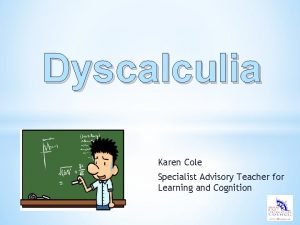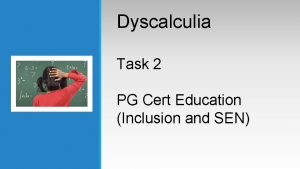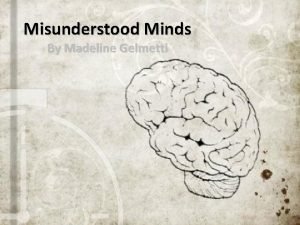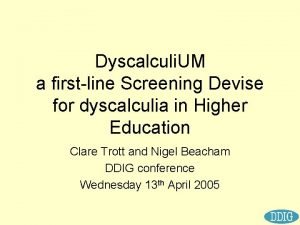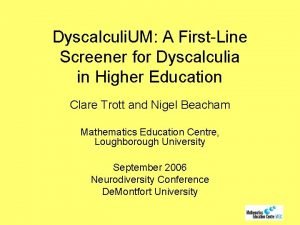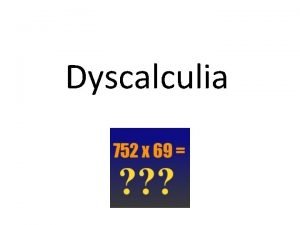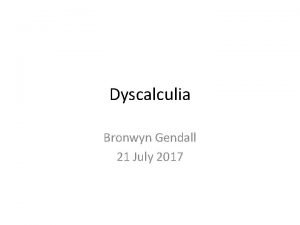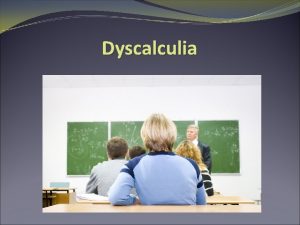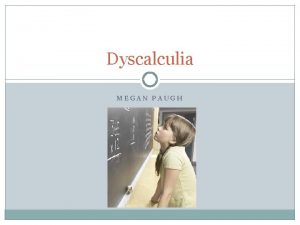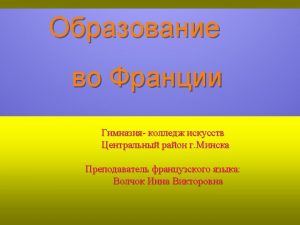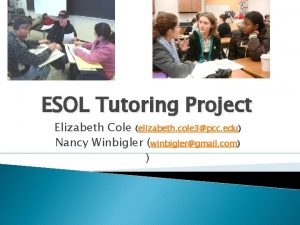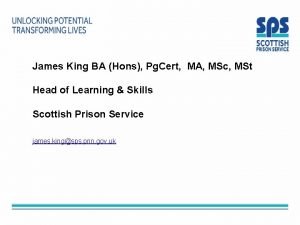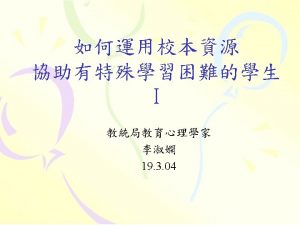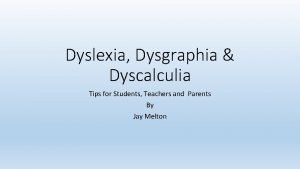Dyscalculia Karen Cole Specialist Advisory Teacher for Learning














































- Slides: 46

Dyscalculia Karen Cole Specialist Advisory Teacher for Learning and Cognition

*Why, How, What Overview *Definitions *Vertical Accelerations *Key indicators of Dyscalculia *Impact *Criteria for assessment/assessment and screeners *Teaching strategies *Resources

Why? Teaching/Learning styles – “if this child does not learn the way you teach, can you teach the way he learns……” (Dr Chasty)

Why? Thinking styles – Are you an inchworm or a grasshopper? (Steve Chinn) 234 +98 = 234 - 98 = 25 x 96 =

Why? Environmental factors– *Classroom *Peer pressure *Grouping within the lesson *Home circumstances *Health

Why? *Maths Anxiety *Confidence *Dyslexia *Dyspraxia *Cognitive abilities/weaknesses *Dyscalculia

Do we only use maths at school? Maths as an adult.

What skills do we need for maths? *Good short term memory *Good working memory *Good visual perception *Secure receptive language skills *Good reading and comprehension skills *Speed of processing

Dyscalculia Definitions use by the BDA *Dyscalculia is a condition that affects the ability to acquire arithmetical skills. Dyscalculic learners may have difficulty understanding simple number concepts, lack an intuitive grasp of numbers and have problems learning number facts and procedures. Even if they produce a correct answer or use a correct method, they may do so mechanically and without confidence. (Df. ES 2001)

Dyscalculia Definitions use by the BDA *A congenital condition: its effects on the learning of numerical skills can be very profound. (Butterworth) *Dysfunction in the reception, comprehension or production of quantitative and spatial information. (Sharma)

Dyscalculia – Chinn’s spectrum Steve Chinn believes that Dyscalculia in along a spectrum and anyone who is diagnosed fits somewhere along the spectrum. Some maths difficulties Dyscalculia

Vertical Acceleration (Sharma) *Intuitive *Concrete *Pictorial *Abstract *Can apply knowledge *Can explain to others www. mathematicsforall. org

Vertical Acceleration (Sharma) *Intuitive *Concrete *Pictorial *Abstract *Can apply knowledge *Can explain to others www. mathematicsforall. org

Key indictors of Dyscalculia Difficulties with; *Identifying a quantity without guessing or counting - subitising *1: 1 correspondence *Estimating whether a numerical answer is reasonable *Counting using immature strategies *Recognising when numbers are bigger or smaller *Short term, long term and working memory *Difficulties counting backwards



Key indictors of Dyscalculia Difficulties with; *Learning times tables *Telling the time *Measuring *Identifying patterns *Transposing numbers – 23/32 78/87 *Organising work on a page *Processing *Communitive law – 23 +12 = 12 + 23

Impact on the curriculum How do maths difficulties impact on the curriculum?

Criteria for Assessment Criteria for assessment according to Thambirajah (2011) *Difficulties with understanding quantities or carrying out basic arithmetic operations inconsistent with the person’s chronological age, educational opportunities or intellectual abilities. *The severity of the difficulty is substantial as assessed by standardised measures of these skills (at the 5 th percentile of achievement) or by academic performance (two school years behind peers) and is persistent. *There is significant interference with academic achievements and the activities of daily living that require mathematical skills. *The arithmetic difficulties are present from an early age and are not due to visual, hearing or neurological causes or lack of schooling.

Diagnostic Protocol - Chinn 1991 *A standardised (norm referenced) test *An assessment of recognition and use of mathematical symbols. *An assessment of basic fact knowledge. *Cognitive style. *An assessment of understanding of place value. *Mathematics language. *A measure of accuracy in calculations.

Diagnostic Protocol - Chinn 1991 *A measure of speed of working. *An assessment of understanding and accuracy in using algorithms – procedures and formulas *A measure of the speed of working – processing. *An analysis of error patterns. *An assessment of an ability to solve word problems. Taken from Steve Chinn’s book – More Trouble with Maths

Checklist?

Assessments and Screeners Dyscalculia Screener by GL Assessment *A 30 minute on line screener *Offers a standardised score *Assesses a pupil’s ability to: Understand number size Simple addition Simple multiplication *Offers a comprehensive report *Guidance for teachers

Assessments and Screeners Sandwell Early Numeracy Test (SENT) a multisensory assessment which highlights gaps in mathematical concepts. Gives an age equivalent. Diagnostic Interview Number Sense. (DINS) a multisensory assessment which highlights gaps in mathematical concepts.

Assessments and Screeners

Assessments and Screeners

Teaching Strategies as part of a Whole School Approach * ALL STAFF should be aware of Dyscalculia *Staff should not assume. *Staff should bear in mind that Dyscalculics can have good knowledge of shape but will have difficulty with number. *They must recognise Sharma’s vertical acceleration.

Teaching strategies *Identify gaps and misconceptions. *Provide learning opportunities which are personalised to the individuals using a whole range of engaging activities. *Always use effective modelling. *Use concrete/pictorial materials to secure understanding.

Teaching strategies *Use effective questioning. *Give instructions in both verbal and pictorial *Be careful with language. Language and vocabulary of maths is complex and often confusing. Example – What is 8 divided into half? What is 8 divided by 2? What is half of 8?

Teaching Strategies *Allow extra time for processing information, instructions and answers. *Provide additional scaffolding. *Have key facts/processes available for support. *Avoid comparisons between peers whenever possible. *Ensure all support is effective, measureable and taught as described.

Your thoughts * A private tutor once per week. * Working with the SENCO once a week, who bought a book on Dyscalculia and is doing her best. * Parents help with homework on a weekend. * During the week her grandfather, who was extremely good at maths helped her during the week. *A teaching assistant helped her at lunch time where she did extra maths, working on a worksheet that the teacher had given her. * The boy next door helped explained some concepts that he knew.

Your thoughts n Co g n i s fu Ov er Communication loa d

Resources Dot patterns *Dot patterns bridge the gap between concrete and abstract work *Will help develop a sense of number *Will help develop the concept of conservation of number *Can be linked to familiar patterns e. g. dice or dominoes

Resources 7 9

Different methods of displaying questions Be mindful of how things are set out. Using arrays of numbers set out in ways which help the children to recognise quantity may help. Use them in the way they are set out on a dice can also help

Numicon *Understanding numbers can be difficult! Numicon enriches children’s mental expressions (concept images) of number to include an image for each number, its place on the number line, the number word and numeral, as well as their everyday number experiences. *It is a multi-sensory approach to teaching maths which raises children’s achievement and increases their confidence. Actions are given to mathematical signs.

Numicon

Ten Town www. tentown. co. uk

Best friends make 10

Number cards


Maths tool kit.

Technology to support Number Shark Maths Gym Nessy – Tables of Doom Nessy – Clock Island Dynamo Maths Jungle Fractions Jungle Coins Maths Academy Manga High Unicorn Maths

Further Support Rapid Maths and Rapid Plus for maths https: //www. pearsonschoolsandfecolleges. co. uk/se condary/English. And. Media/Learning. Support/Rapid. Plu s/Rapid. Plus. aspx Plus 1 Power of 2 is an intensive 1: 1 programme. Passport Maths.

Further Training • British Dyslexia Association - 2 day courses • Dyslexia Action - on-line training • Unicorn Maths - 2 day courses

Reflection *What has been of value to you today ? Discuss *‘What learning will you be taking back into school with you? ’ Discuss The Key Stage Team endeavour to deliver high quality training and in order to do so your thoughts are most valuable to us. Please complete the evaluation slip before you leave. Thank you for your participation.
 Specialist advisory teacher
Specialist advisory teacher Gerstmann syndrome
Gerstmann syndrome Dyscalculia strategies
Dyscalculia strategies Misunderstood minds
Misunderstood minds Dyscalculium
Dyscalculium Dyscalculium
Dyscalculium 5 big ideas maths mastery
5 big ideas maths mastery Nhs learning support fund regional incentive
Nhs learning support fund regional incentive Brooks cole cengage learning
Brooks cole cengage learning Cuadro comparativo e-learning b-learning m-learning
Cuadro comparativo e-learning b-learning m-learning Requirements for erf teacher 2
Requirements for erf teacher 2 Good morning students
Good morning students Kontinuitetshantering i praktiken
Kontinuitetshantering i praktiken Typiska drag för en novell
Typiska drag för en novell Nationell inriktning för artificiell intelligens
Nationell inriktning för artificiell intelligens Returpilarna
Returpilarna Varför kallas perioden 1918-1939 för mellankrigstiden
Varför kallas perioden 1918-1939 för mellankrigstiden En lathund för arbete med kontinuitetshantering
En lathund för arbete med kontinuitetshantering Underlag för särskild löneskatt på pensionskostnader
Underlag för särskild löneskatt på pensionskostnader Vilotidsbok
Vilotidsbok Anatomi organ reproduksi
Anatomi organ reproduksi Förklara densitet för barn
Förklara densitet för barn Datorkunskap för nybörjare
Datorkunskap för nybörjare Boverket ka
Boverket ka Hur skriver man en debattartikel
Hur skriver man en debattartikel Autokratiskt ledarskap
Autokratiskt ledarskap Nyckelkompetenser för livslångt lärande
Nyckelkompetenser för livslångt lärande Påbyggnader för flakfordon
Påbyggnader för flakfordon Lufttryck formel
Lufttryck formel Publik sektor
Publik sektor Jag har gått inunder stjärnor text
Jag har gått inunder stjärnor text Presentera för publik crossboss
Presentera för publik crossboss Vad är ett minoritetsspråk
Vad är ett minoritetsspråk Vem räknas som jude
Vem räknas som jude Treserva lathund
Treserva lathund Fimbrietratt
Fimbrietratt Bästa kameran för astrofoto
Bästa kameran för astrofoto Cks
Cks Byggprocessen steg för steg
Byggprocessen steg för steg Mat för unga idrottare
Mat för unga idrottare Verktyg för automatisering av utbetalningar
Verktyg för automatisering av utbetalningar Rutin för avvikelsehantering
Rutin för avvikelsehantering Smärtskolan kunskap för livet
Smärtskolan kunskap för livet Ministerstyre för och nackdelar
Ministerstyre för och nackdelar Tack för att ni har lyssnat
Tack för att ni har lyssnat Vad är referatmarkeringar
Vad är referatmarkeringar Redogör för vad psykologi är
Redogör för vad psykologi är
